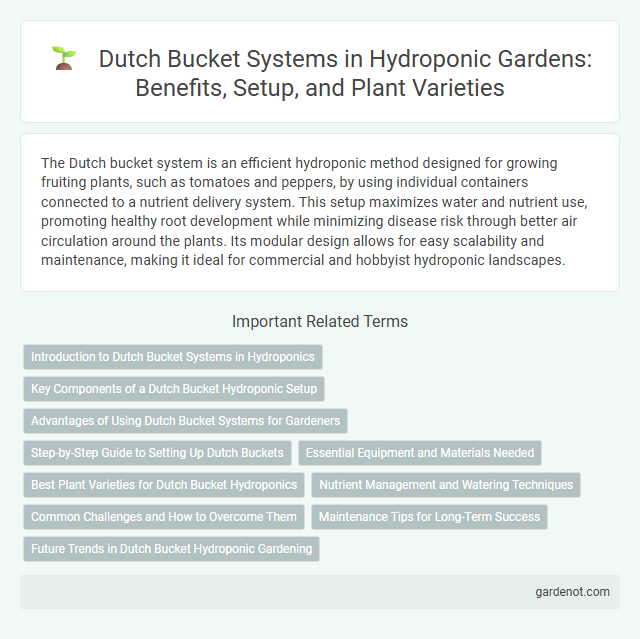The Dutch bucket system is an efficient hydroponic method designed for growing fruiting plants, such as tomatoes and peppers, by using individual containers connected to a nutrient delivery system. This setup maximizes water and nutrient use, promoting healthy root development while minimizing disease risk through better air circulation around the plants. Its modular design allows for easy scalability and maintenance, making it ideal for commercial and hobbyist hydroponic landscapes.
Introduction to Dutch Bucket Systems in Hydroponics
Dutch bucket systems in hydroponics provide an efficient method for cultivating vine crops such as tomatoes, cucumbers, and peppers. Each bucket acts as an individual growing container with a drainage system that recirculates nutrient solution, optimizing water and nutrient use. This system supports healthy root development and promotes high yields in controlled environment agriculture.
Key Components of a Dutch Bucket Hydroponic Setup
A Dutch bucket hydroponic setup centers around key components such as individual buckets, typically made of durable plastic, which function as growing containers filled with an inert growing medium like perlite or coconut coir. Each bucket is equipped with a drainage system connected to a common drain line that recirculates nutrient solution back to the reservoir, ensuring efficient water and nutrient management. The system relies on an irrigation line that supplies a precise nutrient solution mix directly to the root zone, promoting optimal plant growth in crops like tomatoes, peppers, and cucumbers.
Advantages of Using Dutch Bucket Systems for Gardeners
Dutch bucket systems offer gardeners efficient water and nutrient management by recirculating solution, minimizing waste. Their modular design supports diverse crop cultivation with customizable spacing, improving space utilization in hydroponic gardens. Enhanced root aeration and disease control in Dutch buckets promote healthier plant growth and higher yields compared to traditional soil gardening.
Step-by-Step Guide to Setting Up Dutch Buckets
To set up Dutch buckets for hydroponic landscapes, start by selecting durable buckets with drainage holes and installing a sturdy frame to support the system. Connect PVC piping and a water pump to establish a recirculating nutrient solution flow, ensuring even distribution to each bucket. Finally, incorporate an efficient drainage system that funnels excess nutrient solution back to the reservoir for reuse, optimizing water conservation and plant health.
Essential Equipment and Materials Needed
Dutch bucket systems in hydroponic landscapes require essential equipment including durable buckets, drip emitters for precise nutrient delivery, and a reliable water reservoir with a submersible pump to maintain consistent flow. High-quality growing media such as coconut coir or perlite ensures proper root aeration and moisture retention. Additional materials include tubing for irrigation, nutrient solutions formulated for hydroponic growth, and support structures to stabilize the plants within each bucket.
Best Plant Varieties for Dutch Bucket Hydroponics
Tomatoes, peppers, and cucumbers are among the best plant varieties for Dutch bucket hydroponics due to their vine growth habits and high nutrient uptake efficiency. Leafy greens such as lettuce and kale also perform well, benefiting from the precise water and nutrient delivery system of Dutch buckets. Fruit-bearing plants like eggplants and melons thrive in this setup, maximizing yield through optimized root aeration and drainage.
Nutrient Management and Watering Techniques
The Dutch bucket system optimizes nutrient management by delivering precise, recirculated nutrient solutions directly to plant roots, minimizing waste and ensuring consistent nutrient uptake. Watering techniques involve controlled irrigation cycles that maintain optimal moisture levels, preventing both overwatering and nutrient leaching. This method enhances water use efficiency and promotes vigorous plant growth in hydroponic landscapes.
Common Challenges and How to Overcome Them
Dutch bucket systems in hydroponic landscapes often face challenges such as nutrient solution imbalances, root diseases, and water distribution inconsistencies. Maintaining precise nutrient levels through regular monitoring and using well-aerated, pathogen-free media can mitigate root rot and nutrient lockout. Implementing automated irrigation controls and periodic system flushing ensures uniform water delivery and reduces the risk of clogging, enhancing overall plant health and yield.
Maintenance Tips for Long-Term Success
Regularly inspect Dutch bucket systems for clogged drainage holes and algae buildup to ensure optimal water flow and prevent root diseases. Use a balanced nutrient solution and flush the buckets periodically to avoid salt accumulation and maintain nutrient availability. Clean and sanitize the buckets between crop cycles to reduce pests and pathogens, promoting healthy plant growth in hydroponic landscaping.
Future Trends in Dutch Bucket Hydroponic Gardening
Future trends in Dutch bucket hydroponic gardening include the integration of automated nutrient delivery systems powered by AI to optimize plant growth and resource efficiency. Advances in sensor technology enable real-time monitoring of pH, EC, and moisture levels, enhancing precision agriculture practices. Sustainable materials and modular designs are increasingly adopted to reduce environmental impact and facilitate scalability in commercial hydroponic farms.
Dutch bucket Infographic

 gardenot.com
gardenot.com